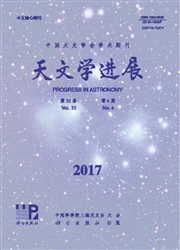

 中文摘要:
中文摘要:
暗物质晕是冷暗物质宇宙学模型下宇宙结构组成的基本单位,暗晕的紧致参数是描述暗晕结构的重要参数,因而在宇宙学诸多研究中得到广泛的应用。主要回顾近年来冷暗物质晕紧致参数的相关研究进展,特别是关于紧致参数与暗晕质量的依赖关系;总结了目前主流的关于紧致参数的理论模型并介绍其各自特点;结合数值模拟结果,讨论了主流模型的实用性。最后对未来紧致参数的研究做了展望。
 英文摘要:
英文摘要:
In a ACDM universe, dark matter halos are the fundamental units building up structures hierarchically. Numerical works show that halos have similar internal structures described by NFW density profile. Concentration and halo mass are the two parameters in the NFW profile. Recent years, the concentration parameter and its dependence on mass and redshift have been well studied in literature. In this paper, I review the studies on halo concentrations in ACDM cosmology. It is found that halo concentration parameter shows a good correlation with halo mass. This is due to the fact halos with different masses have different formation time. People developed severaltheoretical models trying to explain and predict this relation. I review those popular models that have been widely used. The earlier toy models tried to relate the background density of the universe at the time of formation with a properly defined characteristic density of the halo. The concentrations are modelled as a function of mass and redshift with constant amplitudes that are costrtology model dependent. These toy models show very different behaviors at high redshift, and they were proved to somehow fail in later numerical works. Later sophisticated models are based on mass accretion history of the halos. By studying the merger history of halos in details, these works engaged to find out what properties affect the internal structure of the halos as their masses grow. Concentration could then entirely depend on the mass accretion history, and could be predicted with known mass accretion history models. We also compare three recent models. The concentration-mass relations predicted by these models disagree with each other for low mass halos under 106h-lMo and at high redshift. Apart from theoretical probes, numerical studies on concentrations have also been developed using large high resolution simulations available in recent years. Several different works agree that the current average mass-concentration relation is in a power-law form for halos in the
 同期刊论文项目
同期刊论文项目
 同项目期刊论文
同项目期刊论文
 期刊信息
期刊信息
